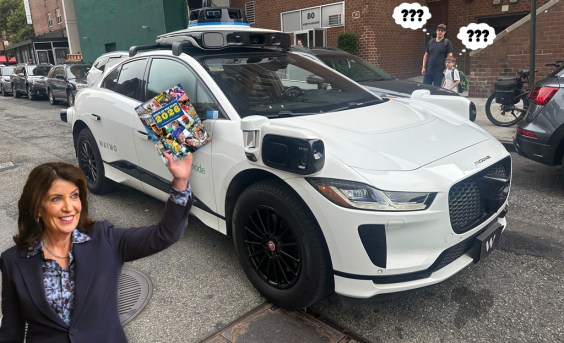 The greenway segment on Flushing Avenue would connect Navy Street to Williamsburg Street West. Image: Google Maps
The greenway segment on Flushing Avenue would connect Navy Street to Williamsburg Street West. Image: Google MapsThe current concept for the Flushing Avenue segment of the Brooklyn Waterfront
Greenway footprint calls for converting the street to one-way westbound traffic flow. Two-way vehicle traffic, say DOT planners, will create conflicts that endanger cyclists and pedestrians as trucks and cars turn left into the Brooklyn Navy Yard. At Wednesday night's public meeting on the project, the one-way conversion didn't sit well with most people who showed up, prompting the DOT team to say they'll take a second look at how the street can be configured.
Toward the end of the event, City Council member Tish James asked for a show of hands: Who'd be satisfied with a bikeway plan where Flushing stays a two-way street? Most people in the crowd of about 80 raised their hands. It's not clear, however, whether the street can accommodate both two-way traffic and a safe, protected path for biking and walking.
For followers of bike lane disputes, the meeting had a little bit of everything. Some speakers cited concerns for bus riders who'd have to wait on Park Avenue, a BQE service road, if eastbound routes get shifted from Flushing. Navy Yard businesses pleaded to keep truck access the way it is now. Other speakers vented typical anti-bike sentiment, calling for bike licensing, registration and fees. Fears that all eastbound traffic on Flushing (a fraction of the westbound traffic heading to the free Manhattan Bridge) would divert to Park Avenue were widespread. And at times, the evening veered into a heated discussion of whom bike infrastructure is meant for.
 The current concept for a Flushing Avenue bikeway. Image: NYCDOT
The current concept for a Flushing Avenue bikeway. Image: NYCDOTRev. Mark V.C. Taylor, pastor of the Church of the Open Door, a black congregation on Gold Street, read prepared remarks accusing DOT of displaying a "deep and profound racism that masquerades as change," adding bike lanes for "young white newcomers." "DOT's concern for black cyclists is non-evident," he said, concluding by asking DOT to "transport ideas like this into the waste bin with ideas like slavery." About a third of the audience belonged to Taylor's congregation.
That came about 30 minutes into a two hour meeting. Once the inflammatory charges were out there, James and others stepped into the role of mediators.
Joan Byron of the Pratt Center for Community Development referred to the ongoing push for greenways in the South Bronx and Sunset Park. "Bike lanes are not exclusively the initiative of white communities," she said. "All communities are entitled to safe places to walk and bike."
From what I heard, a major question from long-time local residents wasn't necessarily "Why a bikeway?" but "Why now?" A few people spoke about riding bicycles when they were kids and wanted to know why the city wasn't proposing this sort of thing 20 or 30 years ago.
Part of the answer is that it takes a long time to build something as complex as the Brooklyn Waterfront Greenway. The basic route was first identified 17 years ago by the Department of City Planning. The idea has gradually accumulated public support, financial momentum, and official approval since then, thanks in large part to the persistence of local activists.
Milton Puryear of the Brooklyn Greenway Initiative recapped some of that history as the meeting drew to a close. "This came out of communities from Greenpoint to Sunset Park," he said, including Farragut Houses, the public housing project at the foot of the Manhattan Bridge that's home to 20,000 residents and many members of the Church of the Open Door. In 2004, a team of
Hunter College graduate students surveyed 133 residents of Farragut Houses. Twenty-five
percent said they biked, and 91 percent said they would use the greenway
in the neighborhood. Out of 31 students in Kindergarten through eighth grade, 25 said they rode
bikes.
"Almost
anyone can afford a bike," Puryear added. "This is a way that people can have mobility.
DOT's motives are not sinister."
Judging by the show of hands at the end of the meeting, a bikeway plan that maintains two-way traffic would meet with less opposition. DOT bicycle
program coordinator Josh Benson said the agency would re-examine
whether the project can work if on-street parking is removed to maintain room
for east-bound lanes. A few greenway supporters could be heard after the meeting wrapped up suggesting east-bound lanes with left-turn bans, a potential compromise that would leave Navy Yard businesses disgruntled about truck access. Whether DOT adjusts its plan or not, the final design won't please everyone.





